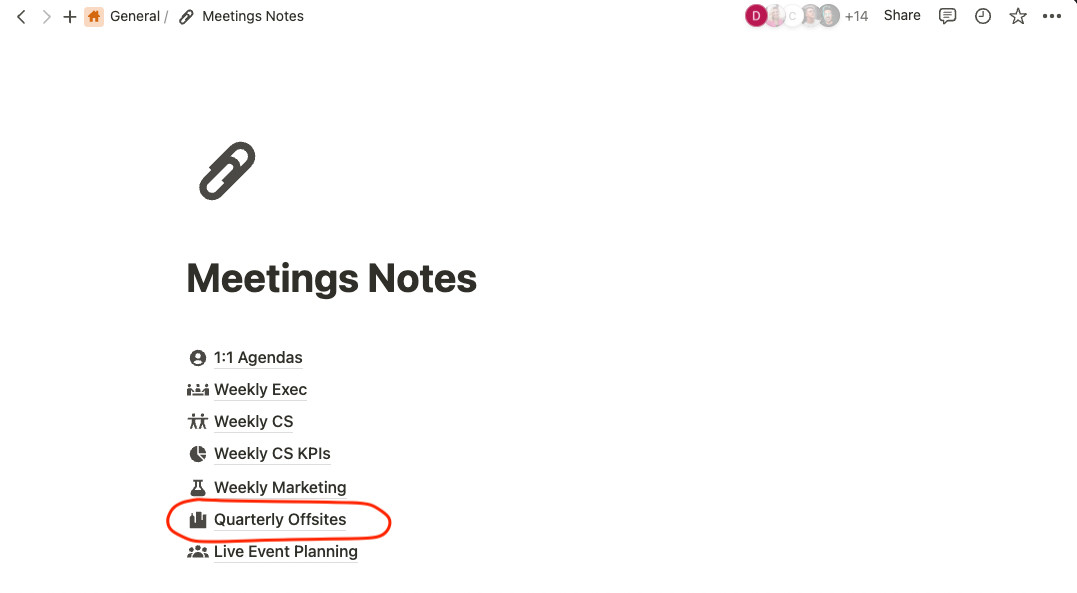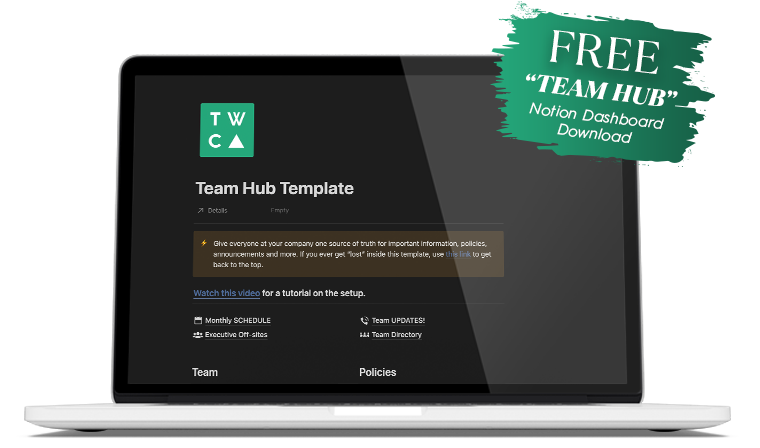Review, Reflect, and Re-center
Our team just completed our quarterly off-site meeting last week, where we analyzed Q4 of 2023, and set targets for the entire year of 2024.
It should probably come as no surprise, but we set some pretty ambitious goals. Goals that the team is excited about hitting (and exceeding).
A common question that we get from our clients is around how we structure and run our planning meetings as a leadership team, how we decide what goals to run toward each quarter/year, and how we rally the team around those goals so that there is a sense of excitement for what we are going to do.
So, we decided to take some time this week to break down what our quarterly planning meetings look like, what makes them so efficient, and some learning lessons for you as you hold planning meetings for your own business!
A Note on How We Do Notes
Before we dive in, an important note on… well… “notes.”
Notes for every meeting inside of our business (no matter what level) are centralized inside of a shared Notion dashboard. Any 1-on-1 meetings between members of the executive leadership, any weekly team huddles, any planning/strategic meetings – all of the notes are housed in one central space.
The outline of the agenda for our quarterly meetings (along with space below each section for notes from each leader and department) are published and linked to weeks before the actual meeting takes place.
Each member of the executive team is notified, and expected to have all sections related to their department filled in before we start the meeting.

Setting the Stage (Alignment)
It’s critically important that, before you spend time plotting out what you want to accomplish, you re-center everyone who will be part of that planning. Re-alignment helps get each person in a healthy headspace for making long-term plans and setting goals that will impact the business.
At the outset of every one of our planning meetings, we go through our Values & Culture statements as an executive team. We read them out loud and sort of “give voice” to what they mean for the business. If you would like to see what these are, they are part of our Team Hub template (free to download now).
This serves simply as a reminder of WHO WE ARE… how we operate, and WHY.
After we’ve read through the Values & Culture, we go around the room and have each leader answer the following questions:
- What’s the best news in the business this year?
- What’s working well in the business right now?
- What’s NOT working well in the business right now?
- Today’s planning meeting would be a win IF…
- Lessons I learned in this last quarter…
Without fail, the first two questions and the last question (about lessons learned) produce gratitude. The third and fourth questions reveal what needs to be addressed and how we can all walk out of the room at the end of the day with clarity on how we are going to move the business forward.
The final thing we do in the introductory portion of the meeting, is review the leadership and responsibilities of the four departments of our business:
- Marketing
- Sales
- Finance
- Operations
Going team by team, we state who the leader is, and what that leader is responsible for as head of that department.
The goal of this is to keep the lanes of each department CLEAR, and to help avoid key players getting pulled into things that shouldn’t actually involve them. It also serves to provide a “filter” when discussing certain initiatives.
“Should Marketing be involved in XYZ this year?” – this question becomes easy to answer when viewed through the filters of the Marketing team’s actual responsibilities.

Analysis and Attribution
The next step of our planning meetings is reviewing the annual objectives that we’ve set for the past year (to see how we’re pacing), and then looking at the objectives from the past quarter.
For instance, at our last quarterly meeting (planning for Q1 2024), we reviewed our 2023 targets as a whole, then broke down our Q4 2023 targets.
When it comes to breaking down the targets from the last quarter, we’re looking to answer two questions ONLY:
- Did we hit this target? Y/N (pass/fail metric)
- Why or why not? (ATTRIBUTION)
Attribution is everything.
If you are measuring a team’s performance relative to a target, but not taking the time to analyze WHY they did or did not achieve it, you are wasting time, effort, and resources, and you may as well stop measuring.
Notice that we’re not just talking about targets that were missed here. Not knowing why you’re winning can be just as catastrophic to your future results as not knowing why you’re losing. Observe, gather data, and strive to understand “why” before you begin formulating a plan for the upcoming quarter.
Setting Quarterly Objectives and Rocks (Key Results)
Now that we’ve spent some time looking at past performance, it’s time to project out into the future.
If you’ve spent sufficient time on the last portion, you’ll have enough context and data to accurately set your targets.
Every quarterly target should be rooted in REAL, observable data… not just arbitrarily set based on gut, instinct, and emotion. It’s good to have hunches, and it’s good to use “feeling” when setting goals (after all, your team should be excited about hitting these). However, every single gut feeling needs to be backed up by real numbers. Data-backed objectives build something that every executive team needs… TRUST.
Once every leader has outlined their objectives for the coming quarter, we move to the “Rocks” or key results.
A quick note on the difference between objectives and “rocks.”
An objective is a measurable, well-defined (often numeric) target.
Example: “Marketing will produce 7,500 customers in Q1.”
A “Rock,” on the other hand, is a supporting initiative that will help you hit that objective.
Example: “Marketing will launch a brand new book funnel in February.”
The objective is 7,500 customers – it’s a measurable, numeric target that serves the growth of the business.
The new book funnel, which will help produce a good chunk of those customers, is a “rock.” It supports a primary objective of the department, but isn’t a primary objective in and of itself.
Once every leader has outlined what targets they will hit in the coming quarter and how they plan to do it, the team discusses (with pushback if necessary) and then we approve the targets and lock them down.
Ratings and Recognition
The last thing that we do before closing any planning meeting is have each person rate the meeting.
If you are familiar with Traction by Gino Wickman, or have heard of his Entrepreneurial Operating System, then you are probably up to speed on why we rate our meetings and how it works.
Essentially, each person assigns a rating to the meeting on a scale of 1 to 10, with 1 being the worst meeting you’ve ever been on in your life, and a 10 being a paragon of perfection. (It would be exceedingly rare to give out either a 1 or a 10, FYI)
A non-exhaustive list of things that can lower the rating of a meeting:
- Starting late
- Ending late
- Not all stakeholders being present
- Not sticking to the meeting agenda
- Not all leaders speaking up or contributing
- Getting “lost in the weeds” – pulled into the minutiae of a specific topic in ways that don’t serve the discussion or wastes the time of the stakeholders
This helps us ensure that meeting quality is being prioritized. If anyone wants to discuss something with the entire group, they have to stop and think of whether that thing is worthy of taking up valuable meeting time with the primary drivers of the business, or if it would waste time and lower the meeting score.
Final Thoughts on Efficiency vs. Effectiveness
It’s worth noting at this point, that sticking to a strict meeting agenda doesn’t ALWAYS serve the business best. There may be times where it is appropriate to pause, give voice to something that’s not being said, or allow space for a discussion that allows every member of the team to feel seen and heard.
Efficiency will always take a back seat to effectiveness.
You should walk out of an effective planning meeting with 3 things:
- An actionable plan
- Clarity on who is owning what
- Buy-in from every leader
Remember, buy-in doesn’t mean that everyone agrees. Don’t confuse “alignment” with “agreement.” It’s far more important that your team is aligned on the goals for the quarter and have a clear understanding of the “how,” than it is that they all agree.
As you head into a new year, you have 4 new quarters to plan. Spend some time thinking about how your planning meetings are structures, and outline an ideal (and effective) agenda that serves your goals!

Get Our Meeting Note Templates
If you’re interested in diving deeper into how we structure meetings and what the notes for our 1:1, quarterly, and annual meetings actually look like, we’ve included templates for all of it as part of our Team Hub download – you can get it now for free!

